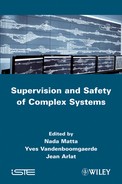Chapter 1
Safety and Performance of Electricity
Production Facilities 1
,
In an increasingly demanding regulatory, legal and social context, power utilities always look for the improvement of the safety and performance of their plants. In the long term they do this by preserving, or even extending the lifetime of their industrial assets. For instance from EDF's (Electricité de France) point of view, this leads to three challenges.
The first challenge is complexity, the complexity of a nuclear, hydraulic or thermal power plant, of an electricity transport network, etc. Risk assessment and management requires understanding a sociotechnical system at every level and in every dimension: the component (itself constituted of elementary components), the equipment (made up of components), the technical system, (combination of pieces of equipment), the individuals and teams organized in complex structures who design or run the system and, last but not least, the environment of the system (natural, technological, organizational, regulation, etc.)
For this challenge, our research projects deal with the methods and tools for the assessment of the risks of a system run by humans, for the design of work situations adapted to humans, and for the organizational diagnostic of the safety and resilience of an organization.
The second challenge is uncertainty. It is everywhere: in physical phenomena and associated hazards, in their measure, their modeling, and in any human activity.
To manage uncertainty, we have to decrease its sources (with more observations, and data) or its consequences (by taking conservative margins), and to use reference methodologies to evaluate all the sources and consequences of uncertainties.
The third challenge is decision-making and action. Here we have the difficulty of managing potential antagonisms inherent to industrial goals. The most obvious, for instance, involves safety and performance, in order to increase at once the short-term performance and durability of the facility. The decision must be made based on a problem that is properly defined and associated with an exhaustive analysis of the stakes carried by the different parties involved. It must also be based on a shared process that associates the parties involved in the decision (experts, managers, external parties etc.), and which accounts for the diversity of risk appraisal.
The GIS 3SGS has enabled developments that will contribute to these challenges being taken up. It is about developing methods, models and tools enabling the probabilistic evaluation of safety and reliability before making a decision, or guiding and justifying the choices of maintenance and investments during operation. It also involves the multicriteria modeling or the cost-benefit approach, bringing together strong and opposable decision elements for the management of industrial risks.
Among the projects presented in this book, we will mention for instance APPRODYN, DEPRADEM and MARATHON.
APPRODYN contributes to the challenge of complexity. It is about experimenting and comparing approaches of dynamic reliability to model the availability of critical systems in a probabilistic way. It focuses in particular on the complex interactions between the physical processes (modeled by continuous variables) and command and control (modeled by discrete variables), in the presence of (stochastic) faults or rare contexts.
MARATHON contributes to the challenge of uncertainty. It focuses on a methodology of risk analysis that enables us to prioritize the risks of sociotechnical systems interacting strongly with their environment. The goal is to identify the different types of uncertainties linked to the knowledge created in this type of analysis (coming from operating experience and experts' claims) and to choose the best method adapted to this integration approach from between the methods of propagation of uncertainties.
The DEPRADEM project focuses on modeling the damage and prognostics in a decision-aid related to maintenance. Its goal is to integrate quantitative data in the maintenance decisions by implementing methods that are able to consider damage mechanisms, their effects and the efficiency of the actions undertaken. It is about introducing rationality to the choices made through a better prediction of the results of maintenance strategies on pieces of equipment in operation. The purpose is to fulfill the safety, security, availability, sustainable development and economic efficiency requirements. The study lies at the interfaces between damage/prognostic and prognostic/decision of maintenance. It is about identifying the methodological adaptations and the tools to be developed so that the prognostics can take into account the results of damage models, and maintenance can take into account the results from a prognostic process.
1 Chapter written by Gilles DELEUZE, Jean PRIMET, Philippe KLEIN, Carole DUVAL and Antoine DESPUJOLS.
